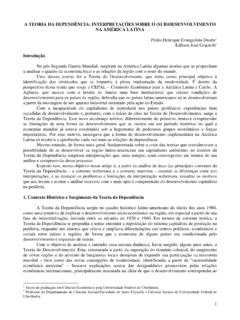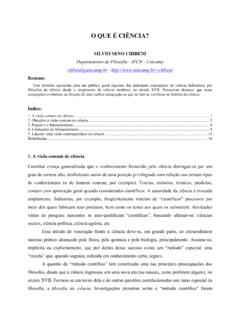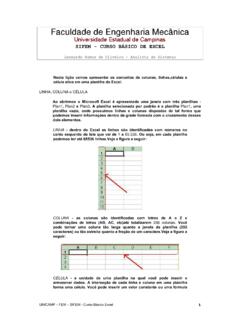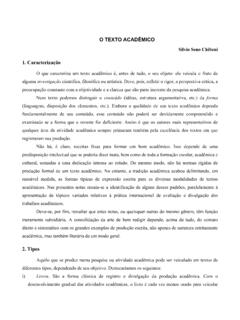Transcription of Heat Flow of the Earth - Unicamp
1 heat Flow of the Earth Carol A. Stein 1. INTRODUCTION Background Earth s evolution reflects the history of heat transfer from the interior [53, 1101 via the fundamental processes of plate tectonics, conduction through con- tinental lithosphere, and hotspot volcanism [103]. As a result, considerable attention has been directed toward understanding Earth s thermal history, the variation in the temperature field in space and tune. The primary directly observable quantity for heat flow is the tem- perature gradient near the surface, which is in turn used to estimate the flow of heat from the interior and hence draw inferences about the thermal structure and evolu- tion. The challenge is the classical one of using the meas- ured temperature and temperature gradient at an object s surface to infer the temperature field within the body, T(x,t), a function of position x and time t.]
2 Near the Earth s surface, the temperature gradient is essentially vertical, so the outward heat flow qs is the product of the vertical gradient of the temperature T(z), which is most everywhere positive downwards (temperature increases with depth z), and the measured or estimated thermal conductivity of the material, k. C. A. Stein, Department of Geological Sciences, University of Illinois at Chicago, 845 W. Taylor Street, Chicago, IL 60607- 7059 Global Earth Physics A Handbook of Physical Constants AGU Reference Shelf 1 Copyright 1995 by the American Geophysical Union Such heat flow measurements (or more precisely esti- mates based on the measured gradient) are the primary boundary conditions used to find the temperature field via the heat equation, ,Cp[ $+v-VT] =V*(kVT)+A, (2) where p is the density, C, is the specific heat , A is the heat generation, and v is the velocity of the moving material [ 25, 1081.]
3 This equation balances the change in the heat content of a body of material with the heat transferred by conduction, brought in by material motion, and generated within the body. Solution of this equation, and hence deduction of temperature structure from heat flow, is a difficult and nonunique inverse problem. The variation in physical properties with depth is significant but uncertain. The expected solid state convection in the mantle has major thermal effects [ 931. As a result, although some inferences about temperature structure can be drawn based largely on heat flow, considerable additional information is drawn from seismological studies [ 961, laboratory and theoretical studies of the physical properties of Earth materials [ 21, and modeling of convection in the Earth [ 481. The measurement of heat flow has thus long been an active research area.]]]]
4 The lirst reported heat flow meas- urements were made in oceanic lithosphere by Revelle and Maxwell [92] and in the continental lithosphere by Benfield [13] and Bullard [23]. The 1966 edition of The Handbook of Physical Constants 1653 listed about 2000 measurements. Since then, the number of heat flow sites included in successive compilations 151, 72, 1021 has increased to about 25,000 listed in the most 144 STEIN 145 recent compilation [87]. Typical values of the surface temperature gradient, conductivity, radioactive heat gen- eration, and heat flow for continents and oceans are listed in Table 1. Measurements and Techniques Despite its conceptual simplicity, the process of deducing heat flow from a measured gradient and con- ductivity values has surprising complexity. Aspects of the problem, including the historical development, are reviewed by various authors: see Louden and Wright [73] for marine studies, Beck [9] and Clauser and Huenges [30] for thermal conductivity, Beck and Bal- ling [ll] for temperatures, and Jessop [50] for both tem- peratures and thermal conductivity.
5 The vertical temperature gradient is computed from temperatures measured at known depths below the sur- face. However, the process of penetrating the surface to measure the temperatures disturbs the thermal structure. For marine measurements, thrusting a probe into the sediments to depths of about 5 m results in frictional heating, which takes from 5 to 30 minutes to dissipate depending mostly on the probe diameter. Prior to 1975 most heat flow values were based on single measure- ments, which were typically spaced about 200 km apart. Subsequently, digital instrumentation has resulted in both better temperature determinations and the capabil- ity to make closely-spaced seafloor ( pogo ) penetra- tions more rapidly than before. Hence, local variations in the heat flux can be better identified and their cause determined.
6 For measurements on land, temperatures are measured in drill holes using down-hole instruments lowered on a cable. For either measurements on land, or in marine boreholes (such as for the DeepSea Drilling Project or the Ocean Drilling Program), calculating the undisturbed temperatures is more complicated. The dril- Table 1. Important Parameters for heat Flow Property, Symbol Approximate Range heat flow, q 0 - 125 mW m-* Vertical temperature gradient, dT/dz 10 to 80 =C/km Thermal conductivity, k marine sediments - W m-l K- continental sediments 1 - 5 W m- K- heat generation, A O-8 lOA W me3 Specific heat , C, kJ kg- C Density of crustal rocks and lithosphere, p 2200 to 3400 kg m-* ling process produces thermal perturbations due to the exchange of heat between the walls of the hole and the drilling fluid in addition to that due to the friction of drilling.
7 With time, the temperatures slowly return to the undisturbed state. Temperature is determined either by waiting sufficient time for the site to return to the presumed equilibrium state, or measuring the change in temperature with time and then calculating an assumed equilibrium temperature [ 111. In some cases the thermal conductivity is measured either in situ or on a sample of the rock recovered and measured in a laboratory. In others, it is estimated based on either the known Ethology or values measured from nearby sites. Initially measurements were made on recovered samples with corrections made for the differences in pressures and temperatures between the laboratory aud the depth from which the sample was recovered [ 911. For marine studies the in situ aud corrected shipboard thermal conductivity measurements agree within about 5% [49].]]
8 In situ determinations are preferred because the sediments have not been disturbed (especially due to water loss) by the coring and tran- sportation. Generally, no attempt is made to measure or correct for the possibility of anisotropic values of con- ductivity, resulting mainly from the anisotropic structure of minerals and rocks. The anisotropy of near-surface marine sediments is negligibly small. Typically the heat flow is calculated from the product of the average thermal conductivity and the thermal gra- dient. If there are significant variations of the conduc- tivity and thermal gradient with depth (typicalIy due to variations in Ethology) the heat flow is estimated. The two most commonly used techniques are the interval method and the Bullard method [90]. The interval method can be used if there is a sufficient density of measurements with depth to assign intervals over which the values of the thermal gradient and conductivity are relatively constant.
9 For each interval, a heat flow is cal- culated from the product of the average temperature gradient and an average conductivity. Then the overall mean heat flow is determined from these interval values. Alternatively, the Bullard method relies on the assumption that in the absence of significant heat sources or sinks and with one-dimensional, steady-state, conductive heat flow, the subsurface temperature T(z) is: T(Z) = TO + Clo&WW~ (3) i=l where To is the surface temperature, qo is the constant heat flow, and k is the conductivity over the ith depth 146 heat FLOW OF THE Earth interval Azi. For each temperature measurement point, the ther~~~al depth, ~(Azt/ kJ~ GUI be calculated. Then, a least-squares fit is made to the data of T(z) with the thermal depth and the slope of the line is equal to the constant heat flow.)
10 Corrections and Climatic Effects The goal of measuring heat flow is to determine the steady-state transfer of heat flow from below. However, the simpliest assumptions that the only uncertainties are from measurement error, the site has uniform horizontal properties and is in a thermal steady state with only conductive heat transfer, are often not the case. Local factors such as topography, sedimentation rates, and sur- face temperature changes, may disturb the heat flux. Given sufficient information, corrections can be made for these factors. Horizontal variations in topography and lithology cause lateral variations in the temperature and, hence surface heat flow. For the oceans, variable sediment thickness and the rough basaltic surface near the measurement site may result in a horizontal com- ponent of heat flow, largely due to the contrast between the lower conductivity of the sediments and the higher values for the basalt [ 14, 54, 1121.]








